Nephron formation adopts a novel spatial topology at cessation of nephrogenesis
- PMID: 21963425
- PMCID: PMC6186757
- DOI: 10.1016/j.ydbio.2011.09.011
Nephron formation adopts a novel spatial topology at cessation of nephrogenesis
Abstract
Nephron number in the mammalian kidney is known to vary dramatically, with postnatal renal function directly influenced by nephron complement. What determines final nephron number is poorly understood but nephron formation in the mouse kidney ceases within the first few days after birth, presumably due to the loss of all remaining nephron progenitors via epithelial differentiation. What initiates this event is not known. Indeed, whether nephron formation occurs in the same way at this time as during embryonic development has also not been examined. In this study, we investigate the key cellular compartments involved in nephron formation; the ureteric tip, cap mesenchyme and early nephrons; from postnatal day (P) 0 to 6 in the mouse. High resolution analyses of gene and protein expression indicate that loss of nephron progenitors precedes loss of ureteric tip identity, but show spatial shifts in the expression of cap mesenchyme genes during this time. In addition, cap mesenchymal volume and rate of proliferation decline prior to birth. Section-based 3D modeling and Optical Projection Tomography revealed a burst of ectopic nephron induction, with the formation of multiple (up to 5) nephrons per ureteric tip evident from P2. While the distal-proximal patterning of these nephrons occurred normally, their spatial relationship with the ureteric compartment was altered. We propose that this phase of nephron formation represents an acceleration of differentiation within the cap mesenchyme due to a displacement of signals within the nephrogenic niche.
Crown Copyright © 2011. Published by Elsevier Inc. All rights reserved.
Figures

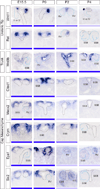
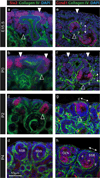
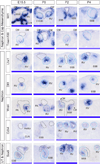

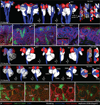
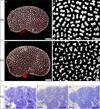
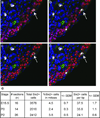

Similar articles
-
Analysis of early nephron patterning reveals a role for distal RV proliferation in fusion to the ureteric tip via a cap mesenchyme-derived connecting segment.Dev Biol. 2009 Aug 15;332(2):273-86. doi: 10.1016/j.ydbio.2009.05.578. Epub 2009 Jun 6. Dev Biol. 2009. PMID: 19501082
-
Cessation of renal morphogenesis in mice.Dev Biol. 2007 Oct 15;310(2):379-87. doi: 10.1016/j.ydbio.2007.08.021. Epub 2007 Aug 16. Dev Biol. 2007. PMID: 17826763 Free PMC article.
-
Osr1 acts downstream of and interacts synergistically with Six2 to maintain nephron progenitor cells during kidney organogenesis.Development. 2014 Apr;141(7):1442-52. doi: 10.1242/dev.103283. Epub 2014 Mar 5. Development. 2014. PMID: 24598167 Free PMC article.
-
Defining and redefining the nephron progenitor population.Pediatr Nephrol. 2011 Sep;26(9):1395-406. doi: 10.1007/s00467-010-1750-4. Epub 2011 Jan 14. Pediatr Nephrol. 2011. PMID: 21229268 Free PMC article. Review.
-
Epigenetic States of nephron progenitors and epithelial differentiation.J Cell Biochem. 2015 Jun;116(6):893-902. doi: 10.1002/jcb.25048. J Cell Biochem. 2015. PMID: 25560433 Free PMC article. Review.
Cited by
-
Renal stem cells: fact or science fiction?Biochem J. 2012 Jun 1;444(2):153-68. doi: 10.1042/BJ20120176. Biochem J. 2012. PMID: 22574774 Free PMC article. Review.
-
DevKidCC allows for robust classification and direct comparisons of kidney organoid datasets.Genome Med. 2022 Feb 22;14(1):19. doi: 10.1186/s13073-022-01023-z. Genome Med. 2022. PMID: 35189942 Free PMC article.
-
Recreating kidney progenitors from pluripotent cells.Pediatr Nephrol. 2014 Apr;29(4):543-52. doi: 10.1007/s00467-013-2592-7. Epub 2013 Sep 13. Pediatr Nephrol. 2014. PMID: 24026757 Free PMC article. Review.
-
Reduction in maternal circulating ouabain impairs offspring growth and kidney development.J Am Soc Nephrol. 2015 May;26(5):1103-14. doi: 10.1681/ASN.2014020130. Epub 2014 Oct 7. J Am Soc Nephrol. 2015. PMID: 25294233 Free PMC article.
-
Concepts for a therapeutic prolongation of nephrogenesis in preterm and low-birth-weight babies must correspond to structural-functional properties in the nephrogenic zone.Mol Cell Pediatr. 2017 Dec 7;4(1):12. doi: 10.1186/s40348-017-0078-6. Mol Cell Pediatr. 2017. PMID: 29218481 Free PMC article. Review.
References
-
- Boyle S, Misfeldt A, Chandler KJ, Deal KK, Southard-Smith EM, Mortlock DP, Baldwin HS, de Caestecker M. Fate mapping using Cited1-CreERT2 mice demonstrates that the cap mesenchyme contains self-renewing progenitor cells and gives rise exclusively to nephronic epithelia. Dev Biol. 2008;313(1):234–245. - PMC - PubMed
-
- Brenner BM, Anderson S. The interrelationships among filtration surface area, blood pressure, and chronic renal disease. J Cardiovasc Pharmacol. 1992;6(19 Suppl):S1–7. - PubMed
-
- Carroll TJ, Park JS, Hayashi S, Majumdar A, McMahon AP. Wnt9b plays a central role in the regulation of mesenchymal to epithelial transitions underlying organogenesis of the mammalian urogenital system. Dev Cell. 2005;9:283–292. - PubMed
Publication types
MeSH terms
Substances
Grants and funding
LinkOut - more resources
Full Text Sources
Other Literature Sources
Molecular Biology Databases
Miscellaneous

